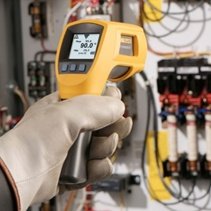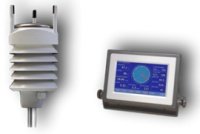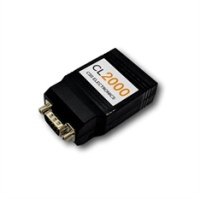Product Review: The Fluke 568 Infrared Thermometer

The Benefits of Infrared and Contact Thermometers
Infrared Thermometer Benefits
Infrared Thermometers are useful for any application where an object's surface area needs to be known quickly and where touching the surface is unsafe, bad practice, or just not possible. They are perfect for measuring such objects as:
- Hot surfaces
- Hard to reach places
- Sterile and cleanroom environments; and
- Moving objects or surfaces.
Contact Thermometer Benefits
Contact Thermometers are considered more accurate than Infrared Thermometers. Compared to Contact Thermometers, Infrared Thermometers can have some limitations, like:
- Readings can be affected temporarily by several things such as ambient temperature changes, radiofrequency and air quality (e.g., dust); and
- Emissivity must be known and accounted for to guarantee accurate results.
The Fluke 568 Infrared Thermometer
Good news! The Fluke 568 Infrared Thermometer combines the best of both worlds in one quality device by coupling the technology of both a Contact Thermometer and an Infrared Thermometer. This feature means you benefit by being able to measure a wide variety of surfaces with confidence.
The Infrared Thermometer component of the device offers an extensive temperature range of -40 °C to 800 °C, together with a host of impressive features that users control through the intuitive menu-driven display. With a few presses of a button, you can adjust emissivity, record data, or turn on and off alarms.
What’s more, the Infrared Thermometer will perform reliably in rugged industrial settings, such as heavy industrial, electrical, HVAC, and mechanical environments.
Summary Features and Benefits -Fluke 568 Infrared Thermometer
Here is a useful and comprehensive checklist you can use when comparing other thermometers to the Fluke 568:
- Range: Fluke 568’s extensive temperature ranges from -40 °C to 800 °C – and it is very accurate.
- Distance to Spot Ratio: The 50:1 distance-to-spot ratio of the Infrared Thermometer component allows you to measure smaller objects from further away.
- Design: The compact yet rugged, ergonomic design is suitable for many workshops, factory or industrial environments.
- LCD Interface: The easy to navigate menu allows users to adjust emissivity, record data, or turn on and off audible and visual alarms.
- Functions: MIN, MAX, AVG, and DIF functions allow you to identify problems quickly.
- Alarms: Audible and visual alarms will instantly alert you to measurements outside of your set limits
- Emissivity: The emissivity level is adjustable. The emissivity menu features a list of pre-defined materials and their typical emissivity values for straightforward adjustment.
- Included Contact Thermocouple: K-Type thermocouple is included with the meter, enabling you to make contact measurements right away. If you already have a K-type thermocouple, the Fluke 568 Infrared Thermometer is compatible with all standard mini connectors.
- Data Storage: The Fluke 568 Infrared Thermometer holds 99 points of date and time-stamped temperature data.
- USB Interface:The USB interface means you can download stored data with a USB connection straight to your PC.
- Included Software:Analyse and trend collected data on the included FlukeView Forms software.
Fluke 568 Infrared Thermometer Specifications
| Feature | Specification |
| IR Temperature Range | -40 °C to 800 °C |
| Accuracy | <0°C: ±(1.0°C + 0.1/1°C) >0°C: ±1% or ±1.0°C, whichever is greater |
| Repeatability | ±0.5 % of reading or ±0.5 °C, whichever is greater. |
| Display Resolution | 0.1 °C |
| Spectral Response | 8 to 14 μm |
| Included K-Type Thermocouple Probe (Bead Type) Measurement Range | -40 °C to 260 °C |
| Included K-Type Thermocouple Probe (Bead Type) Accuracy | ±1.1 °C from 0 °C to 260 °C. Typically within 1.1 °C from -40 °C to 0 °C. |
| Included K-Type Thermocouple Probe (Bead Type) Cable Length | 1 m (40 in) K-type thermocouple cable with standard miniature thermocouple connector and bead termination |
| K-Type Thermocouple Resolution | 0.1 °C |
| Distance: Spot | 50:1 |
| Laser sighting | Single laser, output <1 mW class II, wavelength 630 to 670nm. |
| Emissivity | Digitally adjustable from 0.10 to 1.00 by 0.01 or via a built-in table of common materials |
| Data storage | 99 points |
| Communication | USB 2.0 |
| Battery Life | 12 hours with laser and backlight on; 100 hours with laser and backlight off, at 100 % duty cycle (thermometer continuously on) |
Conclusion
The Fluke 568 Infrared Thermometer is an incredibly popular choice with Instrument Choice customers. The instrument’s accuracy and reliability for measuring temperature in heavy industrial, electrical, HVAC, and mechanical environments, plus features such as temperature measurement range, combined contact, and non-contact measurement functionality and enhanced accuracy, make for a winning combination. If you need an infrared thermometer for an industrial application, we recommend you consider the Fluke 568.
Want more information on the Fluke 568 infrared thermometer or need help evaluating other thermometers, speak with an Instrument Choice Scientist! We're here to help!
Call 1300 737 871 or email [email protected].
Also interesting
The manufacturers of home weather stations have started to include features that have been available only with professional-version devices. This article reveals what you can now expect to find when shopping for a weather station, from modest personal home-use models to advanced feature-rich home instruments and complete professional kits.

The Instrument Choice Team of Scientists regularly reviews new and popular products, so that when you are searching for the perfect scientific instrument for your application, you can make more informed decisions.
In this product review, we will give an overview of the CSS Electronics CL2000 CAN Bus Logger. The CL2000 logger offers user-friendly and straightforward logging of data from a CAN bus without requiring a computer.

